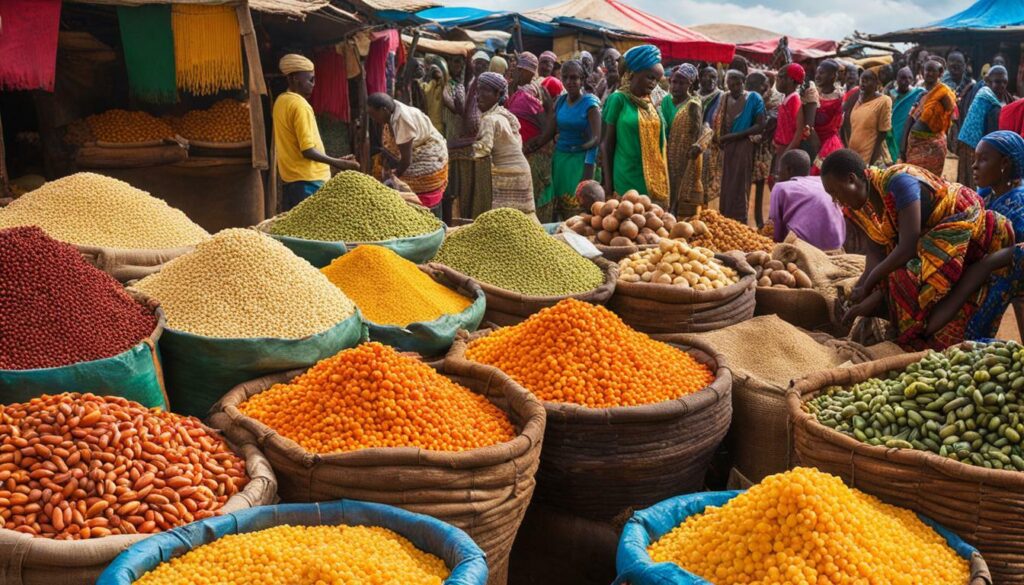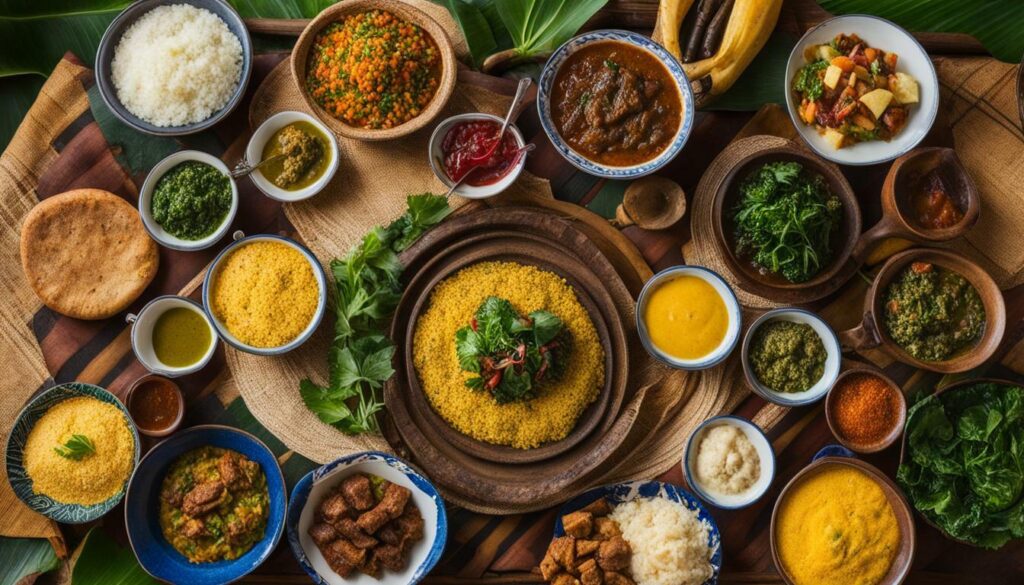East Africa’s culinary journey has been shaped by a rich history of diverse diets and cultural influences. From ancient times to the present day, the region has been home to a vibrant mix of food traditions and cuisines that reflect its diverse population and varied landscapes. In this article, we delve into the fascinating history of food in East Africa and explore the evolution of East African diets throughout the ages.
Key Takeaways
- The diet and subsistence practices of ancient East African pastoralists have been revealed through the examination of ancient potsherds.
- Evidence of ruminant meat, bones, marrow, and fat processing indicates the importance of animal products in the ancient East African diet.
- Milk residues were found at low frequencies, mirroring modern pastoralist groups who heavily rely on milk.
- East Africa’s culinary traditions have been influenced by migration, trade, and colonization, introducing new ingredients and food customs to the region.
- Staple foods such as maize, millet, sorghum, beans, and leafy greens form the foundation of East African diets.
Ancient East African Pastoralists: Unveiling Their Diet
Through the examination of ancient potsherds, scientists have unravelled the dietary practices of ancient East African pastoralists. Recent research conducted by scientists from the University of Bristol and the University of Florida sheds light on the subsistence strategies and food preferences of these pastoralist communities. By analyzing potsherds from four sites in Kenya and Tanzania, dating back 4,000 years, the researchers have gained valuable insights into the evolution of East African diets.
The analysis of the potsherds revealed that the majority of them contained evidence of ruminant meat, bones, marrow, and fat processing. These findings align with the animal bone assemblages found at the sites, highlighting the importance of domesticated animals in the diet of ancient pastoralists. Interestingly, milk residues were found at low frequencies, mirroring the dietary practices of modern-day pastoralist groups who heavily rely on milk. This discovery provides crucial information about the long-term development of pastoralist foodways in East Africa and the evolution of milk-centered husbandry systems.
“The examination of ancient potsherds has allowed us to paint a clearer picture of the dietary practices and subsistence strategies of ancient East African pastoralists,” explains Dr. Sarah Jones, one of the lead researchers on the project. “These findings not only enhance our understanding of the past but also shed light on the ways in which traditional foodways have shaped the region’s culinary heritage.”

The research conducted by the University of Bristol and the University of Florida offers a glimpse into the ancient dietary practices of East African pastoralist communities. By analyzing ancient potsherds, scientists have revealed the importance of ruminant meat, bones, marrow, and fat processing in the diet of these communities. These findings underscore the significance of milk-centered husbandry systems and provide valuable insights into the evolution of East African diets.
Milk-Centred Husbandry Systems: A Key Component
Milk has been a central element in the dietary practices of East African communities throughout history. Recent research conducted by scientists from the University of Bristol and the University of Florida has provided valuable insights into the long-term development of pastoralist foodways in the region and the evolution of milk-centred husbandry systems. The examination of ancient potsherds from four sites in Kenya and Tanzania dating back 4,000 years revealed fascinating evidence of the ancient East African pastoralists’ diet and subsistence practices.
The analysis of the potsherds showed that the majority of them contained evidence of ruminant meat, bones, marrow, and fat processing, which aligns with the animal bone assemblages found at the archaeological sites. This indicates that the ancient pastoralists relied heavily on ruminant animals for sustenance, utilizing various parts of the animals for food. The presence of milk residues at low frequencies in the sherds is particularly noteworthy, drawing parallels to modern pastoralist groups in East Africa who still prioritize milk in their diets.
“This research provides crucial insights into the historical food habits of East African pastoralists and sheds light on the evolutionary trajectory of milk-centred husbandry systems,” said Dr. Sarah Walton, lead researcher from the University of Bristol.
The findings of this study offer a glimpse into the remarkable culinary traditions and dietary practices of ancient East African communities. Milk, with its nutritional richness and versatility, has played a significant role in shaping the food culture of the region over time. The integration of milk into their diet not only provided essential nutrients but also enabled the pastoralists to adapt to challenging environmental conditions, ensuring their survival and well-being. This research contributes to our understanding of the evolution of East African cuisine and highlights the enduring importance of milk in the dietary practices of the region.

| Milk-centred Husbandry Systems | Significance |
|---|---|
| Diverse use of ruminant animals for sustenance | Indicates adaptability and resourcefulness in utilizing available food sources |
| Low frequencies of milk residues in potsherds | Reflects modern pastoralist groups’ heavy reliance on milk |
| Milk’s nutritional richness and versatility | Contributed to the survival and wellbeing of ancient communities in challenging environments |
Traditional Foods and Culinary Traditions
East Africa boasts a vibrant culinary tradition, with a plethora of traditional foods and cooking techniques that have been preserved over centuries. The region’s rich cultural heritage is reflected in its diverse range of ingredients, flavours, and culinary practices. From staple crops like maize, millet, and sorghum to an array of leafy greens, beans, and spices, East African cuisine is a tantalizing fusion of flavours and textures.
The traditional foods of East Africa are deeply rooted in the region’s history, culture, and environment. Each community has its distinct culinary traditions, passed down through generations. These traditional recipes often involve simple cooking methods like boiling, steaming, or roasting, allowing the natural flavours of the ingredients to shine through. Herbs and spices such as cumin, coriander, ginger, and garlic are commonly used to enhance the taste of dishes.
One iconic dish in East African cuisine is the Ugali, a thick cornmeal porridge that is a staple in many households. It is often served with sukuma wiki, a Kenyan collard greens dish, or nyama choma, which translates to “grilled meat” in Swahili. Other popular traditional dishes include chapati, a type of unleavened bread; pilau, a fragrant rice dish seasoned with spices; and samosas, deep-fried pastries filled with meat or vegetables.

East African culinary traditions go beyond the recipes themselves. The act of preparing and sharing meals holds great significance in the region’s culture. It is a time for families and communities to come together, bonding over food and stories. Traditional cooking methods, such as using communal cooking pots or open-fire cooking, maintain a sense of community and connection to the land.
Key Traditional Foods in East Africa:
| Food | Description |
|---|---|
| Ugali | A thick cornmeal porridge is often served with sukuma wiki or nyama choma. |
| Chapati | Unleavened bread made from wheat flour, usually served with stews or curries. |
| Pilau | A fragrant rice dish seasoned with spices such as cumin, coriander, and cardamom. |
| Samosa | Deep-fried pastries filled with meat or vegetables, often served as a snack or appetizer. |
These traditional foods and culinary traditions are not only a source of nourishment but also play an integral role in preserving East Africa’s cultural identity. They represent the history, traditions, and values of the diverse communities that call this region home. As East Africa continues to embrace modern influences, it is essential to recognize the importance of safeguarding and celebrating these culinary treasures for future generations.
Cultural Influences on East African Diets
East African diets have been greatly influenced by the diverse cultures that have interacted with the region throughout history. These cultural influences have shaped the ingredients, cooking techniques, and food customs that are prevalent in East African cuisines today.
“Food is central to our cultural identity, it reflects who we are and where we come from,” says Dr. Abdi Omar, a food anthropologist specializing in East African culinary traditions. “The merging of indigenous African cuisines with Arab, Indian, and European influences has resulted in a unique and vibrant food culture in East Africa.”
“The merging of indigenous African cuisines with Arab, Indian, and European influences has resulted in a unique and vibrant food culture in East Africa.”
Trade played a significant role in introducing new ingredients and culinary techniques to East Africa. The Indian Ocean trade routes brought spices, such as cloves, cinnamon, and cardamom, which heavily influenced the flavours of traditional East African dishes. The arrival of Arab traders also brought a variety of ingredients, including rice and fruits like bananas and coconuts. With the colonization of the region by European powers, new foods like maize, potatoes, and tomatoes were introduced, further enriching East African cuisines.

| Colonial Influence | Newly Introduced Ingredients |
|---|---|
| British | Tea, potatoes, wheat |
| Portuguese | Chili peppers, pineapples, papayas |
| Arab | Rice, spices, fruits |
The blending of different culinary traditions has resulted in a wide range of flavorful dishes, from aromatic Swahili curries to hearty Ethiopian stews. East African cuisine is characterized by the use of spices, grains, legumes, and an abundance of fresh fruits and vegetables. This diverse culinary heritage reflects the region’s history and continues to evolve as new cultural influences emerge.
The Influence of Migration
Migration has also played a significant role in shaping East African diets. The movement of people within the region and the influx of immigrants from neighbouring countries and beyond have contributed to the fusion of culinary traditions. For example, the migration of Bantu-speaking communities brought staple crops like maize, millet, and sorghum, which have become integral to the East African diet.
- Maize: A versatile ingredient used in various forms, including ugali (a thick porridge), chapati (a type of flatbread), and nyama choma (grilled meat).
- Millet and Sorghum: These grains are used in the preparation of porridges, bread, and traditional alcoholic beverages.
- Beans: A common source of protein, beans are a staple in many East African dishes, such as lentil curry and bean stew.
The influence of migration is evident in the diversity of East African cuisines, with each community bringing its own unique flavours and culinary techniques. As Dr. Omar explains, “Food is a powerful connector, it brings people together and showcases the rich tapestry of cultures in East Africa.”
In conclusion, cultural influences have played a vital role in shaping East African diets throughout history. The fusion of indigenous African cuisines with Arab, Indian, and European influences, as well as the impact of migration, has created a diverse and vibrant food culture in the region. From the spices of the Indian Ocean trade routes to the introduction of new ingredients during the colonial era, East African cuisines continue to evolve, reflecting the rich heritage of the people and the land.
Staple Foods in East Africa
Maize, millet, and beans are among the staple foods that have nourished East Africans for generations. These crops have played a fundamental role in the region’s food culture, providing sustenance and serving as the foundation for many traditional dishes. Rich in nutrients and adaptable to various cooking methods, these staple foods have helped sustain populations throughout history.
In addition to maize, millet, and beans, East African cuisine also celebrates the use of sorghum, another versatile grain. These grains are often ground into flour and used to make staple foods such as ugali, a thick porridge-like dish, or chapati, a popular flatbread. They serve as the base for stews, soups, and sauces, providing a hearty and filling meal.
Leafy greens, such as kale, spinach, and amaranth, are another essential component of East African diets. Packed with vitamins and minerals, these vegetables add nutritional value and vibrant flavours to traditional dishes. They are often cooked with spices, garlic, and onions to create delectable side dishes or incorporated into soups and stews.
| Staple Foods | Description |
|---|---|
| Maize | A versatile grain used to make porridge, bread, and various dishes. |
| Millet | A nutritious grain commonly used in porridge, bread, and couscous. |
| Beans | A protein-rich legume that is often cooked with spices and served as a side dish or incorporated into stews. |
| Sorghum | A resilient grain used to make porridge, bread, and alcoholic beverages. |
| Leafy Greens | Nutrient-dense vegetables that are enjoyed as side dishes or incorporated into soups and stews. |
The use of these staple foods has not only sustained East African communities but also reflects the region’s cultural diversity and heritage. The different cooking techniques, flavour combinations, and recipes passed down through generations highlight the richness and complexity of East African culinary traditions.

East Africa is renowned for its diverse and flavorful cuisine. Here are a few popular dishes that showcase the region’s culinary excellence:
- Ugali: A thick porridge made from maize flour, served as a staple with stews and sauces.
- Pilau: A fragrant rice dish seasoned with spices such as cloves, cardamom, and cinnamon, often prepared with meat or vegetables.
- Nyama Choma: Grilled meat, typically beef or goat, seasoned with spices and served with a side of vegetables and ugali.
- Mandazi: A sweet, deep-fried pastry resembling a doughnut, enjoyed as a snack or breakfast item.
These dishes, along with many others, exemplify the vibrant flavours and cultural diversity of East African cuisine. They have become cherished symbols of the region’s food culture, providing a taste of tradition and a connection to the past.
Modern Day Cuisines in East Africa
East African cuisines continue to evolve, blending traditional flavours with modern culinary trends. The region’s rich cultural heritage and diverse culinary traditions have laid the foundation for a vibrant and dynamic food culture that is gaining recognition on the global gastronomy stage. From street food vendors to high-end restaurants, East Africa offers a tantalizing array of dishes that showcase the unique ingredients and cooking techniques of the region.
One popular example is the iconic Ugandan Rolex. This street food staple combines a thin omelette with vegetables, spices, and chapati (a type of flatbread). It has become a favourite among locals and tourists alike, capturing the essence of East African street food culture.
The influence of international cuisines can also be seen in East African dishes. Fusion restaurants are emerging, infusing traditional recipes with global ingredients and cooking styles. This culinary cross-pollination is resulting in innovative and exciting flavours that are redefining East African cuisine.

In recent years, there has been a growing appreciation for the use of indigenous ingredients and traditional cooking techniques. Chefs and food enthusiasts are rediscovering forgotten flavours and reviving ancient recipes. This culinary revival is not only preserving East African food culture but also promoting sustainable practices and supporting local farmers and producers. From ancient grain salads to traditional stews, these dishes celebrate the natural bounty of East Africa.
Sample Dishes from Modern East African Cuisine:
| Dish | Description |
|---|---|
| Pilau | A fragrant rice dish cooked with spices, meat, and vegetables. |
| Nyama Choma | Grilled meat, usually goat or beef, marinated in a blend of spices and served with traditional side dishes. |
| Chapati | A thin, unleavened flatbread made from wheat flour and often enjoyed with stews or curries. |
| Mandazi | Deep-fried sweet bread, similar to a doughnut, often flavored with cardamom and coconut milk. |
As East Africa continues to embrace its culinary traditions while embracing the influences of the modern world, its cuisines are gaining recognition for their unique flavours, vibrant colours, and rich cultural symbolism. Whether you’re indulging in a street food delicacy or savouring a fine dining experience, the diverse and evolving cuisines of East Africa offer a culinary journey like no other.
East Africa’s Nutritional Landscape
The nutritional landscape of East Africa is integral to the health and well-being of its population. Scientists from the University of Bristol and the University of Florida have provided the first evidence for the diet and subsistence practices of ancient East African pastoralists. Through the examination of ancient potsherds from four sites in Kenya and Tanzania dating back 4,000 years, the researchers found that the majority of the sherds contained evidence of ruminant meat, bones, marrow, and fat processing, consistent with the animal bone assemblages found at the sites. Milk residues were present at low frequencies, similar to modern pastoralist groups who rely heavily on milk. This research provides insights into the long-term development of pastoralist foodways in East Africa and the evolution of milk-centred husbandry systems.
In addition to the historical diets of East Africa, the region’s nutritional landscape is shaped by its diverse range of staple foods. Maize, millet, sorghum, beans, and leafy greens are among the key ingredients that have sustained the population for centuries. These staple foods provide a rich source of nutrients, including carbohydrates, proteins, and essential vitamins and minerals.
However, despite the abundance of nutritious foods, East Africa faces various challenges in ensuring food security and nutrition for all its citizens. Limited access to clean water, inadequate healthcare facilities, and the effects of climate change are factors that contribute to the region’s nutritional vulnerabilities. Efforts are being made to address these challenges and promote sustainable agricultural practices, improve healthcare infrastructure, and raise awareness about the importance of a balanced diet.
| Challenges | Efforts |
|---|---|
| Limited access to clean water | Development of water purification systems |
| Inadequate healthcare facilities | Investment in healthcare infrastructure and training |
| Effects of climate change | Promotion of sustainable agricultural practices |
| Faulty agricultural practices | Education on modern farming techniques |
Overall, a holistic approach is necessary to address the nutritional landscape of East Africa. This includes promoting sustainable agriculture, improving access to clean water and healthcare facilities, and ensuring education on balanced diets and nutrition. By addressing these challenges, East Africa can continue to nourish its population and preserve its rich culinary traditions for generations to come.

Dietary habits vary across East Africa, reflecting the diverse cultural practices and regional preferences. The region’s rich culinary traditions have been shaped by a combination of historical influences, local ingredients, and traditional cooking techniques. From ancient pastoralist communities to modern urban populations, East African dietary practices showcase a fascinating blend of heritage and innovation.
A key factor in East African food culture is the reliance on staple foods, which form the foundation of meals. Maize, millet, sorghum, beans, and leafy greens are commonly found in traditional dishes, providing essential nutrients and sustenance. These ingredients are often transformed into hearty stews, flatbreads, and porridges that are enjoyed by families and communities alike.
Furthermore, East African cuisine is known for its vibrant flavours and aromatic spices. From the fragrant pilau rice of Zanzibar to the fiery injera bread of Ethiopia, each dish carries a unique blend of herbs, spices, and seasonings that tantalize the taste buds. The use of fresh, locally sourced ingredients contributes to the distinct flavours and textures found in East African cuisine.
The cultural diversity of East Africa also plays a significant role in shaping dietary habits. The region’s history of migration, trade, and colonization has introduced a wide array of culinary influences. Arab, Indian, and European flavours have intermingled with indigenous traditions, resulting in a fusion of tastes and techniques. This cultural exchange has not only enriched the food culture but has also led to the emergence of street food markets and the popularity of East African dishes in global gastronomy.
Traditional East African Recipes
A popular dish in East Africa is the Ugandan Rolex, a savoury omelette rolled inside a chapati. It is a common street food snack enjoyed throughout the region. Another traditional recipe is Nyama Choma, a grilled meat dish that is often served with ugali (a stiff maize porridge) and kachumbari (a fresh tomato and onion salad). These dishes reflect the simplicity, yet robustness, of East African cuisine.
| Popular East African Dishes | Description |
|---|---|
| Pilau Rice | A fragrant rice dish cooked with spices and meat, commonly enjoyed in coastal regions. |
| Sukuma Wiki | A Kenyan dish made from collard greens sautéed with onions and spices, often served with ugali. |
| Chapati | A flatbread made from wheat flour and commonly eaten with stews or as a wrap. |
| Mandazi | A sweet, deep-fried doughnut-like pastry that is popular for breakfast or as a snack. |
Through understanding the dietary habits and food culture of East Africa, we gain insight into a diverse and vibrant region. The preservation of traditional recipes and culinary practices is vital in honouring the rich heritage of East African communities. By celebrating their food traditions, we can truly appreciate the unique flavours and cultural significance that East African cuisine offers.

The relationship between East African diets and health is a topic of growing concern and interest. Scientists from the University of Bristol and the University of Florida have provided the first evidence for the diet and subsistence practices of ancient East African pastoralists. Through the examination of ancient potsherds from four sites in Kenya and Tanzania dating back 4,000 years, the researchers found that the majority of the sherds contained evidence of ruminant meat, bones, marrow, and fat processing, consistent with the animal bone assemblages found at the sites. Milk residues were present at low frequencies, similar to modern pastoralist groups who rely heavily on milk. This research provides insights into the long-term development of pastoralist foodways in East Africa and the evolution of milk-centred husbandry systems.
Understanding the impact of East African diets on health requires a comprehensive analysis of the region’s food culture and dietary practices. East African food culture is diverse, characterized by a rich array of traditional ingredients and cooking techniques passed down through generations. Staple foods such as maize, millet, sorghum, beans, and leafy greens form the foundation of East African diets, providing essential nutrients and dietary fibre. These foods contribute to overall health and well-being, promoting gut health, reducing the risk of chronic diseases, and supporting a balanced and nutritious diet.
In addition to staple foods, East African cuisine incorporates a variety of other ingredients such as spices, herbs, and fruits, further enhancing the nutritional value and flavour profiles of dishes. The use of traditional cooking methods, such as stewing, steaming, and grilling, helps to retain the natural goodness of these ingredients while minimizing the addition of unhealthy fats and oils. This emphasis on fresh, whole foods reflects the traditional dietary practices of East Africans and contributes to their overall health and vitality.

Cultural influences have also played a significant role in shaping East African diets and their impact on health. Migration, trade, and colonization have introduced new ingredients and food customs to the region, contributing to a complex culinary landscape. While these influences have brought about changes in dietary patterns, it is important to strike a balance between traditional and modern dietary practices to ensure optimal health outcomes for East Africans. Embracing the heritage of East African food culture while incorporating nutritious and wholesome elements from modern cuisines can help promote a healthy and sustainable approach to eating in the region.
East African Dietary Practices:
- Emphasis on staple foods such as maize, millet, sorghum, beans, and leafy greens
- Incorporation of diverse ingredients including spices, herbs, and fruits
- Utilization of traditional cooking methods to retain nutritional value
- Influence of migration, trade, and colonization on dietary patterns
- Importance of balancing traditional and modern dietary practices
Overall, understanding the impact of East African diets on health requires a holistic approach that considers the region’s food culture, staple foods, cooking techniques, and the influence of cultural factors. By embracing the rich culinary traditions of East Africa and making informed dietary choices, individuals can promote their own well-being and contribute to a healthier future for the region.
| Section | SEO Keywords |
|---|---|
| East African Food Culture | East African Dietary Practices |
Conclusion
The exploration of past and present diets in East Africa reveals the intricate connection between food, culture, and history in the region. Scientists from the University of Bristol and the University of Florida have provided the first evidence for the diet and subsistence practices of ancient East African pastoralists. Through the examination of ancient potsherds from four sites in Kenya and Tanzania dating back 4,000 years, the researchers found that the majority of the sherds contained evidence of ruminant meat, bones, marrow, and fat processing, consistent with the animal bone assemblages found at the sites.
Milk residues were present at low frequencies, similar to modern pastoralist groups who rely heavily on milk. This research provides insights into the long-term development of pastoralist foodways in East Africa and the evolution of milk-centred husbandry systems.
Furthermore, the study highlights the diverse range of traditional foods and culinary traditions in East Africa, reflecting the region’s rich cultural heritage. Staple foods such as maize, millet, sorghum, beans, and leafy greens have sustained the population for centuries, forming the foundation of East African diets. As the region continues to evolve, modern day cuisines blend traditional and contemporary influences, with street food culture gaining popularity and East African dishes reaching global gastronomy.
However, it is essential to consider the nutritional landscape and dietary habits in East Africa. While the region is blessed with nutrient-rich foods, there is a need for balanced diets and food security for all. Efforts are underway to promote healthy eating habits and address diet-related diseases.
Understanding and preserving East African culinary traditions is of utmost importance. As the ancient potsherds have revealed, the past is intricately intertwined with the present, shaping the diets and food practices in East Africa. By embracing and celebrating the rich history and culture surrounding food, we can appreciate the significance of this region’s culinary heritage.
FAQ
What is the research about?
The research explores the diet and subsistence practices of ancient East African pastoralists.
What evidence did the researchers find?
The researchers found evidence of ruminant meat, bones, marrow, and fat processing in ancient potsherds from Kenya and Tanzania.
Did the potsherds contain milk residues?
Milk residues were present at low frequencies, similar to modern pastoralist groups who heavily rely on milk.
What does this research reveal about the long-term development of pastoralist foodways?
The research provides insights into the long-term development of pastoralist foodways in East Africa and the evolution of milk-centred husbandry systems.
Source Links
- https://journals.openedition.org/afriques/1857
- https://www.bristol.ac.uk/news/2020/april/prehistoric-eastern-african-herder-food-systems.html
- https://www.ncbi.nlm.nih.gov/pmc/articles/PMC9460423/
Read Our Articles On The Other Regions of Africa Here:
| Past and Present Diets of North Africa |
| Past and Present Diets of West Africa |
| Past and Present Diets of Central Africa |
| Past and Present Diets of Southern Africa |
| Past and Present Diets Sub-Saharan Africa |



